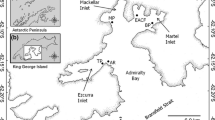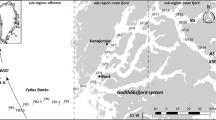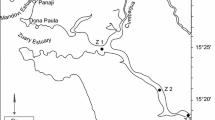Abstract
The structure and summertime production of planktonic communities and the role of nondiatom planktonic cells were studied in coastal ponds, which are areas traditionally used for fattening and greening table-sized oysters. The abundance and biomass of nano–microplanktonic protists were determined at weekly intervals between February 1998 and February 1999 in a coastal pond without oysters in the French Atlantic coast near La Rochelle. The production of these microbiotas was determined in the summer period. The structure of plankton communities revealed the following observations: (1) microphytoplanktonic cells were mostly diatoms and dinoflagellates, (2) microzooplanktonic cells were mainly ciliates, and (3) nanoplanktonic cells were represented by pigmented (80–90% of the nanoplankton biomass) and colorless nanoflagellates. Diatoms were dominated by Naviculiineae. Dinoflagellates were dominated by Peridiniales. Oligotrichida were predominant in the ciliate community. Protist biomass levels were nine times higher from April to August (summer period 1033 μg C L−1) than from September to March (winter period 114 μg C L−1). Whatever the season, nanoflagellates were dominant in the water column (66 and 53% of the entire protist biomass in the summer and winter periods, respectively). Nanoflagellates represented the highest production of nano–microplanktonic communities (76% of carbon protist production) in the coastal pond in summer and showed the shortest generation time (7.1 h). Dinoflagellates came after nanoflagellates in production (19.5% of carbon protist production). Diatoms represented only a supplementary carbon resource available for higher trophic levels, whereas, until now, they were considered as the principal food of oysters in coastal ponds. Ciliates were a small source of carbon, but their growth rate was high. We suggest, first, that nanoflagellates represented the primary resource available in the pond and could constitute an important food resource for higher trophic levels, such as oysters, farmed in this type of pond. Overall, the system appeared to be more autotrophic than heterotrophic. Because inorganic nutrients are quickly exhausted in a semiclosed pond, pigmented flagellates dominated the carbon biomass, production and biomass of bacteria were high (thus, the microbial food web appeared to be active in this pond), and mixotrophy seemed to be an important trophic mode there.










Similar content being viewed by others
References
Azam, F, Fenchel, T, Field, JG, Gray, JS, Meyer-Reil, LA, Thingstad, F (1983) The ecological role of water-column microbes in the sea. Mar Ecol Prog Ser 10: 257–263
Barillé, L, Prou, J, Héral, M, Bougrier, S (1993) No influence of food quality, but ration-dependent retention efficiencies in the Japanese oyster Crassostrea gigas. J Exp Mar Biol Ecol 171: 91–106
Berk, SG, Brownlee, DC, Heinle, DR, Kling, Colwell, RR (1977) Ciliates as a food source for marine planktonic copepods. Microb Ecol 4: 27–40
Blanchard, G, Sauriau, PG, Cariou-Le Gall, V, Gouleau, D, Garet, MJ, Olivier, F (1997) Kinetics of tidal resuspension of microbiota: testing the effects of sediment cohesiveness and bioturbation using flume experiments. Mar Ecol Prog Ser 151: 17–25
Carlough, LA, Meyer, JL (1989) Protozoans in two southeastern blackwater rivers and their importance to trophic transfer. Limnol Oceanogr 34: 163–177
Caron, DA (1983) Technique for enumeration of heterotrophic and phototrophic nanoplankton, using epifluorescence microscopy, and comparison with other procedures. Appl Environ Microbiol 46: 491–498
Chrétiennot-Dinet, MJ, Guillocheau, N (1987) Etude des diatomées d'écosystèmes marins côtiers. Observations nouvelles en microscopie électronique. Cah Biol Mar 28: 271–279
Crottereau, C (1999) Dynamique des populations bactériennes dans un marais maritime atlantique: contribution des activités ectoproteolytique et d'uptake des acides aminés à la production bactérienne. PhD Océanologie, Université d'Aix-Marseille II, p 216
Delmas, D, Frikha, MG, Reymond, H, Linley, EAS, Collos, Y (1992) Long-term microbial community dynamics in a coastal marine pond. Mar Microb Food Webs 6: 39–54
Dolan, JR (1991) Guilds of ciliate microzooplankton in the Chesapeake Bay. Estuar Coast Shelf Sci 33: 137–152
Dupuy, C, Le Gall, S, Hartmann, HJ, Bréret, M (1999) Retention of ciliates and flagellates by the oyster Crassostrea gigas in French Atlantic coastal ponds: protists as a trophic link between bacterioplankton and benthic suspension-feeders. Mar Ecol Prog Ser 177: 165–175
Epstein, SS, Shiaris, MP (1992) Size-selective grazing of coastal bacterioplankton by natural assemblages of pigmented flagellates, colorless flagellates, and ciliates. Microb Ecol 23: 211–225
Fenchel, T (1988) Ecology of Protozoa—The Biology of Free-Living Phagotrophic Protists. Springer-Verlag, Berlin
Fenchel, T, Jonsson, PR (1988) The functional biology of Strombidium sulcatum, a marine oligotrich ciliate (Ciliophora, Oligotrichina). Mar Ecol Prog Ser 48: 1–15
Ferrier-Pagès, C, Rassoulzadegan, F (1994) Seasonal impact of the microzooplankton on pico- and nanoplankton growth rates in the northwest Mediterranean Sea. Mar Ecol Prog Ser 108: 283–294
Ferrier-Pagès, C, Gattuso, JP (1998) Biomass, production and grazing rates of pico- and nanoplankton in coral reef waters (Miyako Island, Japan). Microb Ecol 35: 46–57
Frikha, MG, Linley, EAS, Delmas, D (1987) Evolution annuelle et saisonnière de la microbiomasse d'une claire à huîtres : importance des populations bactérioplanctoniques. Oceanis 13: 433–447
Gaines, G, Elbrächter, M (1987) Heterotrophic nutrition. In: Taylor, FJR (Ed.) The Biology of Dinoflagellates, Blackwell Scientific Publications, Oxford, pp 224–268
Gifford, DJ, Dagg, MJ (1991) The microzooplankton-mesozooplankton link: consumption of planktonic protozoa by the calanoid copepods Acartia clausi Dana and Neocalanus plumchrus Murukawa. Mar Microb Food Webs 5: 161–177
Haas, LW (1982) Improved epifluorescence microscopy for observing planktonic microorganisms. Ann Inst Océanogr 58: 261–266
Hall, JA, Barrett, DP, James, MR (1993) The importance of phytoflagellate, heterotrophic flagellate and ciliate grazing on bacteria and picophytoplankton sized prey in a coastal marine environment. J Plankton Res 15: 1075–1086
Hartmann, HJ, Taleb, H, Aleya, L, Lair, N (1993) Predation on ciliates by the suspension-feeding calanoid copepod Acanthodiaptomus denticornis. Can J Fish Aquat Sci 50: 1382–1393
Havskum, H, Riemann, B (1996) Ecological importance of bacterivorous, pigmented flagellates (mixotrophs) in the Bay of Aarthus, Denmark. Mar Ecol Prog Ser 137: 251–263
Héral, M (1987) Shellfish Culture Development and Management—Aquaculture International Seminar, La Rochelle 4–9 mars 1985. Evaluation of the Carrying Capacity of Molluscan Shellfish Ecosystems. IFREMER, Brest
Jonsson, PR, Tiselius, P (1990) Feeding behaviour, prey detection and capture efficiency of the copepod Acartia tonsa feeding on planktonic ciliates. Mar Ecol Prog Ser 60: 35–44
Kahl, A (1931) Urtiere oder protozoa. In: Dahl, F, Dahl, M, Bischoff, H (Eds.) Die Tierwelt Deutschlands und der angrenzenden Meeresteile. Gustav Fischer, Jena
Klaveness, D (1992) Augmentation of the food supply for oyster larvae via bacterivorous flagellates: possible implications for larval breeding and oyster pond management. Aquac Fish Manage 23: 591–597
Korringa, P (1976) Farming the cupped oysters of the genus Crassostrea. A multidisciplinary treatise. Developments in Aquaculture and Fisheries Science, vol. 2. Elsevier Scient Publ Comp, Amsterdam
Landry, MR, Hassett, RP (1982) Estimating the grazing impact of marine micro-zooplankton. Mar Biol 67: 283–288
Landry, MR, Kirshtein, J, Constantinou, J (1995) A refined dilution technique for measuring the community grazing impact of microzooplankton with experimental tests in the central equatorial Pacific. Mar Ecol Prog Ser 20: 53–63
Leakey, RJG, Burkill, PH, Sleigh, MA (1994) A comparison of fixatives for the estimation of abundance and biovolume of marine planktonic ciliate populations. J Plankton Res 16: 375–389
Leakey, RJG, Burkill, PH, Sleigh, MA (1996) Planktonic ciliates in the northwestern Indian Ocean: their abundance and biomass in waters of contrasting productivity. J Plankton Res 18: 1063–1071
Le Gall, S, Bel Hassen, M, Le Gall, P (1997) Ingestion of a bacterivorous ciliate by the oyster Crassostrea gigas: protozoa as a trophic link between picoplankton and benthic suspension-feeders. Mar Ecol Prog Ser 152: 301–306
Lee, JJ, Hutner, SH, Bovee, EC (Eds.) (1985) An Illustrated Guide to the Protozoa. Allen Press, Lawrence, KS, p 615
Lovejoy, C, Vincent, WF, Frenette, JJ, Dodson, JJ (1993) Microbial gradients in a turbid estuary: application of a new method for protozoan community analysis. Limnol Oceanogr 38: 1295–1303
Malone, TC, Ducklow, HW (1990) Microbial biomass in the coastal plume of Chesapeake Bay: phytoplankton–bacterioplankton relationships. Limnol Oceanogr 35: 296–312
Nezan, E (1996) Surveillance du phytoplancton marin: manuel illustré adapté à la formation des analystes. IFREMER, Brest, p 77
Ohman, MD, Snyder, RA (1991) Growth kinetics of the omnivorous oligotrich ciliate Strombidium sp. Limnol Oceanogr 36: 922–935
Paulmier, G (1997) Tintinnides (Ciliophora, Oligotrichida, Tintinnina) de l'atlantique boréal, de l'océan indien et de quelques mers adjacentes: Mediterranée, mer Caraïbe, mer Rouge. Inventaires et distribution. Observations basées sur les loricas. IFREMER, Brest, p 126
Pierce, RW, Turner, JT (1994) Plankton studies in Buzzards Bay, Massachusetts, USA. III. Dinoflagellates, 1987 to 1988. Mar Ecol Prog Ser 112: 225–234
Pomeroy, LR (1974) The ocean's food web, a changing paradigm. Bioscience 24: 499–504
Putt, M, Stoecker, DK (1989) An experimentally determined carbon:volume ratio for marine “oligotrichous” ciliates from estuarine and coastal waters. Limnol Oceanogr 34: 1097–1103
Ricard, M (1987) Atlas du phytoplancton, vol. 2. Eds du CNRS, Paris, p 297
Riisgård, HU (1988) Efficiency of particle retention and filtration rate in 6 species of Northeast American bivalves. Mar Ecol Prog Ser 45: 217–223
Rincé, Y (1978) Intervention des diatomées dans l'écologie des claires ostréicoles dans la baie de Bourgneuf. PhD Biologie Marine, Nantes, p 203
Robert, JM, Maestrini, SY, Dréno, JP, Gonzalez-Rodriguez, E (1979) Estimation au moyen de tests biologiques de la fertilité pour trois diatomées des eaux des claires à huîtres de Vendée. Oceanol Acta 2: 275–286
Robert, JM (1983) Fertilité des eaux des claires ostréicoles et verdissement: utilisation de l'azote par les diatomées dominantes. PhD Sciences, Nantes
Sanders, RW, Porter, KG, Bennett, SJ, DeBiase, AE (1989) Seasonal patterns of bacterivory by flagellates, ciliates, rotifers and cladocerans in a freshwater community. Limnol Oceanogr 34: 673–687
Sherr, EB, Sherr, BF, Paffenhöfer, GA (1986) Phagotrophic protozoa as food for metazoans: a “missing” trophic link in marine pelagic food webs? Mar Microb Food Webs 1: 61–80
Sherr, BF, Sherr, EB, Fallon, RD (1987) Use of monodispersed, fluorescently labeled bacteria to estimate in situ protozoan bacterivory. Appl Environ Microbiol 53: 958–965
Sherr, BF, Sherr, EB, Pedros-Alio, C (1989) Simultaneous measurement of bacterioplankton production and protozoan bacterivory in estuarine water. Mar Ecol Prog Ser 54: 209–219
Sherr, EB, Rassoulzadegan, F, Sherr, BF (1989) Bacterivory by pelagic choreotrichous ciliates in coastal waters of the NW Mediterranean Sea. Mar Ecol Prog Ser 55: 235–240
Sherr, EB, Sherr, BF (1994) Bacterivory and herbivory: key roles of phagotrophic protists in pelagic food webs. Microb Ecol 28: 223–235
Sherr, EB, Caron, DA, Sherr, BF (1994) Staining of heterotrophic protists for visualisation via epifluorescence microscopy. In: Kemp, PF, Sherr, BF, Sherr, EB, Cole, JJ (Eds.) Handbook of Methods in Aquatic Microbial Ecology. Lewis Publishers, Boca Raton, FL, pp. 213–227
Shumway, SE, Cucci, TL, Newell, RC, Yentsch, CM (1985) Particle selection, ingestion, and absorption in filter-feeding bivalves. J Exp Mar Biol Ecol 91: 77–92
Sime-Ngando, T, Juniper, K, Vézina, A (1992) Ciliated protozoan communities over Cobb Seamount: increase in biomass and spatial patchiness. Mar Ecol Prog Ser 89: 37–51
Sime Ngando, T, Gosselin, M, Roy, S, Chanut, JP (1995) Significance of planktonic ciliated protozoa in the Lower St Lawrence Estuary: comparison with bacterial, phytoplankton and particulate organic carbon. Aquat Microb Ecol 9: 243–258
Stoecker, DK (1998) Conceptual models of mixotrophy in planktonic protists and some ecological and evolutionary implications. Eur J Protistol 34: 281–290
Sournia, A (1986) Atlas du phytoplancton marin, vol. 1. Eds du CNRS, Paris, p 219
Turpin, V, Robert, JM, Goulletquer, P (1999) Limiting nutrients of oyster pond seawaters in the Marennes-Oléron region for Haslea ostrearia: applications to the mass production of the diatom in mesocosm experiments. Aquat Living Resour 12: 335–342
Zanette, Y (1980) Intervention de quelques facteurs dans l'évolution de la biomasse des claires de Marennes-Oléron. Cons Inst Explor Mer C M L 45: 11
Zubkov, MV, Sleigh, MA (1995) Ingestion and assimilation by marine protists fed on bacteria labeled with radioactive thymidine and leucine estimated without separating predator and prey. Microb Ecol 30: 157–170
Acknowledgments
We thank M. Bréret for technical assistance, A. Pastoureaud for critical review of the manuscript, and Janet Heard Carnot for reviewing the grammatical context. This study was carried out with financial support from the Conseil Général de Charente-Maritime.
Author information
Authors and Affiliations
Corresponding author
Rights and permissions
About this article
Cite this article
Dupuy, C., Ryckaert, M., Le Gall, S. et al. Seasonal Variations in Planktonic Community Structure and Production in an Atlantic Coastal Pond: The Importance of Nanoflagellates. Microb Ecol 53, 537–548 (2007). https://doi.org/10.1007/s00248-006-9087-z
Received:
Accepted:
Published:
Issue Date:
DOI: https://doi.org/10.1007/s00248-006-9087-z




